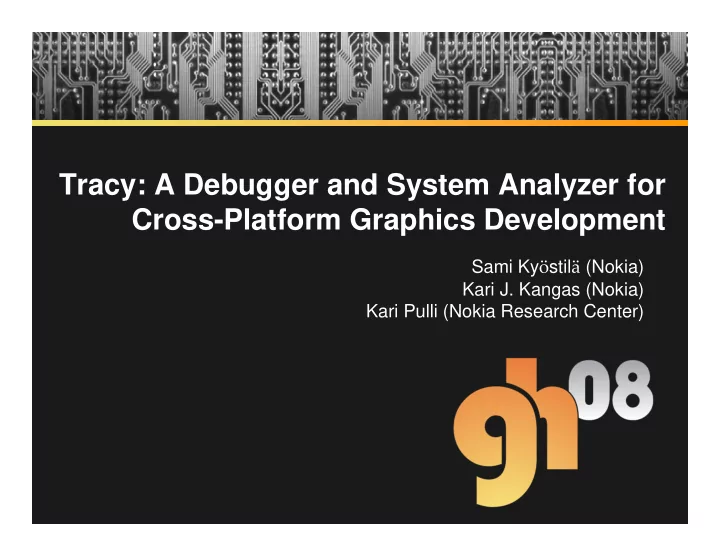

Tracy: A Debugger and System Analyzer for Cross-Platform Graphics Development Sami Ky ö stil ä (Nokia) Kari J. Kangas (Nokia) Kari Pulli (Nokia Research Center)
Motivation Mobile graphics development environment • Cross-platform • Cross-company • Immature and evolving Common tasks • Error isolation • Optimization • Performance estimation 1
Overview Tracy architecture Related work Workflow, common use-cases Data-driven API configuration • Code generation, state tracking Trace compression Trace analysis and transformation Conclusion 2
Tracy architecture Components • Tracer • Trace player • Trace analyzer Cross-platform Optimized for mobiles Data-driven design • OpenGL ES, OpenVG, EGL 3
Related work Tracing: Tracing interactive 3D graphics programs (Dunwoody & Linton, 1990), Chromium (Humphreys et al., 2002) State tracking: Tracking graphics state for networked rendering (Buck et al., 2000) Graphical debugging: PerfHUD (NVIDIA), gDEBugger (graphicREMEDY), PIX (Microsoft) 4
Workflow Main use-cases 1. Debug visual errors and performance problems 2. Analyze application quality 3. Benchmark graphics engine 5
Use case 1: Graphics debugging Original application Trace on reference engine Rendering error in application Play trace on reference engine Reference engine output OK � bug in the engine Isolate test frame and debug 6
Use case 2: Analyze application quality Offline trace analysis Graphics expert system Quality problems • High resource utilization • Suboptimal API usage 7
Use case 3: Benchmark graphics engine Benchmarking with traces Two approaches • Trace player: overhead • Native code Edit traces • Custom benchmarks Single frame • Steady-state benchmarks 8
ANSI C code generation Trace � platform-independent ANSI C source code • Highly portable Very low performance overhead � benchmarking and profiling • • Challenges • Compiler limitations • Workaround: data arrays in assembly language 9
Data-driven API configuration C header files • API functions, objects and constants API configuration • Special functions • State structure • Serialization rules Platform-specific data 10
API configuration example glLightfv ( GLenum light , GLenum pname , const GLfloat * params ) params array: 4 components by default If pname equals GL_SPOT_DIRECTION: 3 components If pname equals GL_SPOT_EXPONENT: 1 component 11
State tracking S tate tree: graphics API state Branches: function call parameters � map API calls to state changes Use cases • Implicitly defined parameters • API state computation • Trace optimization 12
State tracking example OpenGL ES Vertex buffer objects (VBO) glBindBuffer() – Set active VBO glBufferData() – Set active VBO data � glBufferData depends on glBindBuffer Dependency encoded in state tree paths: glBindBuffer() � root.vbo.handle • glBufferData() � root.vbo.handle.data • • glBindBuffer() path is a prefix for glBufferData() path 13
Trace compression Runtime trace compression • Internal copies of reused arrays Benefits: ~10-100x reduction in size, 1 FPS � 10 FPS improvement in tracing performance • 14
Trace analysis and transformation 15
Trace analysis: Frame extraction Cull redundant commands, create state setup sequence Use cases • Error isolation • Test design • Benchmark design 16
Conclusion Offline graphics debugging Optimized for mobile graphics Flexible data-driven design Reliable profiling and benchmarking Future work • OpenGL ES 2.0 • Content clustering for benchmarking 17
Thank you – Questions? Sami Ky ö stil ä <sami.kyostila@nokia.com> Kari J. Kangas <kari.j.kangas@nokia.com> Kari Pulli <kari.pulli@nokia.com>
Recommend
More recommend